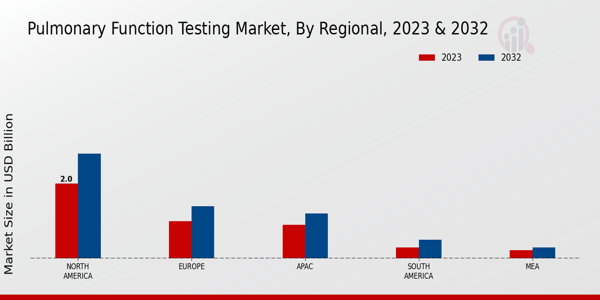Rising Awareness of Respiratory Health
The Pulmonary Function Testing Market is benefiting from a growing awareness of respiratory health among the general population. Educational campaigns and public health initiatives are informing individuals about the importance of lung function and the risks associated with poor respiratory health. This increased awareness is leading to higher rates of testing and diagnosis, particularly in at-risk populations. Recent statistics suggest that the prevalence of respiratory diseases is on the rise, prompting healthcare providers to recommend regular pulmonary function tests. As more individuals seek to understand their lung health, the demand for pulmonary function testing is expected to continue its upward trajectory.
Increased Focus on Preventive Healthcare
The Pulmonary Function Testing Market is witnessing a heightened emphasis on preventive healthcare measures. As healthcare systems shift towards proactive management of diseases, pulmonary function tests are increasingly utilized to identify respiratory issues before they escalate. This trend is supported by initiatives aimed at early detection of conditions such as asthma and chronic obstructive pulmonary disease (COPD). The integration of pulmonary function testing into routine health check-ups is becoming more common, thereby expanding the market. Data indicates that early intervention can significantly reduce healthcare costs associated with advanced respiratory diseases, further driving the demand for pulmonary function testing.
Aging Population and Respiratory Diseases
The Pulmonary Function Testing Market is significantly influenced by the aging population, which is more susceptible to respiratory diseases. As individuals age, the risk of developing conditions such as COPD and pulmonary fibrosis increases, necessitating regular pulmonary function assessments. The demographic shift towards an older population is prompting healthcare systems to adapt by incorporating more pulmonary function testing into routine care. Projections indicate that by 2030, the number of individuals aged 65 and older will increase substantially, thereby expanding the market for pulmonary function testing. This demographic trend underscores the need for effective monitoring and management of respiratory health in older adults.
Regulatory Support and Reimbursement Policies
The Pulmonary Function Testing Market is positively impacted by supportive regulatory frameworks and favorable reimbursement policies. Governments and health organizations are increasingly recognizing the importance of pulmonary function tests in diagnosing and managing respiratory diseases. This recognition is leading to improved reimbursement rates for these tests, making them more accessible to patients. Enhanced reimbursement policies encourage healthcare providers to incorporate pulmonary function testing into their practice, thereby driving market growth. Data suggests that regions with robust reimbursement frameworks see higher utilization rates of pulmonary function tests, indicating a direct correlation between policy support and market expansion.
Technological Advancements in Pulmonary Function Testing
The Pulmonary Function Testing Market is experiencing a surge in technological advancements that enhance diagnostic accuracy and patient experience. Innovations such as portable spirometers and advanced software for data analysis are becoming increasingly prevalent. These technologies facilitate real-time monitoring and remote testing, which is particularly beneficial for patients with chronic respiratory conditions. According to recent data, the market for pulmonary function testing devices is projected to grow at a compound annual growth rate of approximately 8% over the next few years. This growth is driven by the demand for more efficient and user-friendly testing solutions, which are essential for timely diagnosis and management of respiratory diseases.





















Leave a Comment